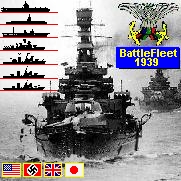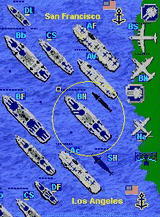Pacific War Battleship Game
BattleFleet 1939 Game
Battleship Pac.War
Battleship PC Game
Armada Battleship Game
General Battleship Game
Battleship Chess Game
SeaWar 2 - The Battleship Game
SeaWar - Battleship PC Game
Standard Battleship PC game
Battleship Game - WW2 Naval
Strategy: the best choice among aircraft carrier games
and submarine games.
Missions and Scenarios:
Pearl Harbor Game
Atlantic Game 1943
Sink Cruisers Game
Midway Game
Iwo Jima Game
US Marines Game
Luftwaffe Game Pacific
Torpedo Game Boats
Bismarck Game Pacific
Destroy RAF Game
Okinawa
Us Navy Submarine Game
Fleet Submarines Game
Kamikaze Game
U Boat Game
Singapore Game
Swordfish Hunt
Patrol Boats
Air Supremacy
Alert
Battleships Game
Java
Defense
Fleet Cruisers Game
Atlantic Island
Coral Sea Game
Iron Sea
Mykonos
Imperial Ocean
Long Convoy
Skagerrak
Target Los Angeles
West Pacific Game
Pacific War Game
Leyte Transport
Emperor Hirohito
Normandy Game
South Pacific Game
Destroy USAF Game
Submarine Games
US Navy Game
Free Hunt Doenitz Game
Free Hunt Spruance Game
Free Hunt Halsey Game
Imperial Navy I
Royal Navy Game
Free Hunt Pearl Harbor Games
Midway II
Kriegsmarine I
Brisbane Convoy
Clear West Coast
Fall Of Australia
Battle For Leyte
Conquer Of Japan
HMAS Perth
Road To Okinawa
Orange Ports
Emperor Defense
Prince Of Wales
San Bernardino
Pacific Race
Heavy Duty
Tokio Express
Operation Sidney
Bomber Operation
Conquer Of Italy
Heavy Cruiser Game
Frigate Hunt
Santa Cruz
Lamansh Game
Azores Transport
Norway Convoy
Invasion
Grossadmiral
Norway Ports
Drang Nach Ost
Convoy Pk30
Ciano Defense
Sir John Tovey
Free Hunt Andrews
Germans On Pacific
Silent Hunt
Antigua
Return To Midway
Kriegsmarine Game II
Royal Air Force Game
F. Hunt Lancaster
Jamamoto Game
Free Hunt USN
Free Hunt Japan
Free Hunt RAAF
Free Hunt U Boat Game
Free Hunt Aircraft Carriers Game
Free Hunt Hawaii
Free Hunt Yamato Game
Free Hunt Iwo Jima Game
Free Hunt Pacific Game
Free Hunt Torpedos
Free Hunt Convoy
Free Hunt Germany
Free Hunt Germany II
Free Hunt Italy
Free Hunt Malaya
Free Hunt Subs Game
Free Hunt B-29 Game
Free Hunt USN 1944
Devil Island
Dragoon Carriers
|
Maginot
Line
The Maginot Line was a line of concrete fortifications,
tank obstacles and machine gun posts, together with other
defences which France constructed along her borders with
Germany and with Italy in the wake of World War 1. The
Maginot Line refers to either the entire system or just
the defences facing Germany while the Alpine Line is used
for the Franco-Italian defences. The French believed the
fortification would provide time for their army to
mobilise in the event of attack and also compensate for
numerical weakness. The success of static, defensive
combat in World War I was a key influence on French
thinking.
The defenses were first proposed by Marshal Joffre, he
was opposed by modernists such as Paul Reynaud and
Charles de Gaulle who favoured investment in armour and
aircraft. Joffre had support from P?tain and there were
a number of reports and commissions organised by the
government. But it was Andr? Maginot who convinced the
government to invest in the scheme. Maginot was another
veteran of World War I who became France's Minister of
Veteran Affairs and then Minister of War (1928-1932).
| CIA / KGB intelligence
game. Run your own operation
game. Travel around the world and set up
espionage game, trade with state secrets, weapon
systems, spy codes, WMD, hire secretaries,
agents, lawyers and soldiers, establish secret
agent stations, cells and bases and search for
criminals and politicians. Involve in agent game.
Game contains more than 40 missions including
Nuclear Game, Cold War Game, Secret Agent, CIA
Games, USAF, Prime Minister, RAF, Bin Laden,
Sadam, KGB, Operations Iran… |
|
The line was built in a number of
phases from 1930 by the STG (Section Technique du Genie)
overseen by CORF (Commission d'Organization des R?gions
Fortifi?es). The main construction was largely completed
by 1935 at a cost of around 3 billion francs. The
specification of the defenses was very high, with
extensive and interconnected bunker complexes for
thousands of men, there were 108 main forts (ouvrages) at
15 Kilometer intervals, smaller ouvrages and casements
between with over 100 Kilometers of tunnels.
The fortifications did not extend through the Ardennes
Forest ("impenetrable" and
"impassable") or along the border with Belgium
because the countries had signed an alliance in 1920, by
which the French army would operate in Belgium if the
German forces invaded. When Belgium abrogated the treaty
in 1936 and declared neutrality, the Maginot Line was
quickly extended along the Franco-Belgian border, but not
to the standard of the rest of the Line. There was a
final flurry of construction in 1939-40 with general
improvements all along the Line. The final Line was
strongest around the industrial regions of Metz, Lauter
and Alsace, while other areas were in comparison only
weakly guarded.
The German invasion plan of 1940 (Sichelschnitt) was
designed to deal with the Line. A decoy force sat
opposite the Line while a second Army Group cut through
the Low Countries of Belgium and the Netherlands, as well
as through the Ardennes Forest which lay north of the
main French defenses. Thus the Germans were able to avoid
assaulting the Maginot Line directly. Attacking from May
10, the German forces were well into France within five
days and they continued to advance until May 24, when
they stopped near Dunkirk. By early June the German
forces had cut the Line off from the rest of France and
the French government was making overtures for an
armistice. But the Line was still intact and manned with
a number of commanders wanting to hold out; and the
Italian advance had been successfully contained. Still
Maxime Weygand signed the surrender and the army was
ordered into captivity.
When the Allied forces invaded in June 1944 the Line was
again largely bypassed, with fighting only touching a
part of the fortifications near Metz and in northern
Alsace towards the end of 1944.
After the war the Line was re-manned by the French and
underwent some modifications. However when France
withdrew from NATO much of the Line was abandoned. With
the rise of the French independent nuclear deterrent by
1969 the Line was largely given up by the government,
with sections auctioned off to the public and the rest
left to decay.
The term "Maginot Line" has been used as a
metaphor for something that is confidently relied upon
despite being ineffectual. In fact, it did exactly what
it was intended to do, sealing off a section of France,
and forcing an aggressor around it. As originally
envisioned, the Maginot Line was part of a larger defense
plan, in which the attackers would meet with resistance
from the French Army, but the French did not implement
the latter part, leading to the loss of effectiveness of
the Line.
Maginot Line
Specification
The Maginot Line specification of the defences was
very high, with extensive and interconnected bunker
complexes for thousands of men; there were 45 main forts
(grands ouvrages) at intervals of 15 kilometres (9.3
miles), 97 smaller forts (petits ouvrages) and 352
casemates between, with over 100 kilometres (62 miles) of
tunnels. Maginot Line Artillery was coordinated with
protective measures to assure that one fort could support
the next in line by bombarding it directly without harm.
The largest guns were therefore 135 mm (5.3 in) fortress
guns; larger weapons were to be part of the mobile forces
and were to be deployed behind the lines.
The Maginot Line fortifications did not extend through
the Ardennes Forest (which was believed to be
impenetrable) or along France's border with Belgium,
because the two countries had signed an alliance in 1920,
by which the French army would operate in Belgium if the
German forces invaded. When Belgium abrogated the treaty
in 1936 and declared neutrality, the Maginot Line was
quickly extended along the Franco-Belgian border, but not
to the standard of the rest of the Line. As the water
table in this region was high, there was the danger of
underground passages getting flooded, which the designers
of the line knew would be difficult and expensive to
overcome.
There was a final flurry of construction in
1939–1940 with general improvements all along the
Line. The final Maginot Line was strongest around the
industrial regions of Metz, Lauter and Alsace, while
other areas were in comparison only weakly guarded. In
contrast, the propaganda about the line made it appear
far greater a construction than it was; illustrations
showed multiple stories of interwoven passages, and even
underground railyards and cinemas. This reassured allied
civilians.
The Maginot Line Purposes
The Maginot Line was built to
fulfil several purposes:
- To avoid a surprise attack and
to give alarm.
- To cover the mobilisation of
the French Army (which took between 2 and 3
weeks).
- To save manpower (France
counted 39,000,000 inhabitants, Germany
70,000,000).
- To protect Alsace and Lorraine
(returned to France in 1918) and their industrial
basin.
- To be used as a basis for a
counter-offensive.
- To push the enemy to
circumvent it while passing by Swiss and Belgium
- To hold the enemy while the
main army could be brought up to reinforce the
line.
- To show non aggressive
posture, and compel the British to help France if
Belgium is invaded
Armoured cloches
There are several kinds of armoured cloches. The word
cloche is a French term meaning bell due to its shape.
All cloches were made in an alloy steel. Cloches are
non-retractable turrets.
* The most widespread are the GFM cloches, where GFM
means Guettor fusil-mitrailleur - Rifle machine-gun. They
are composed of 3 to 4 openings, called crenels or
embrasures. These crenels may be equipped as follows:
Rifle machine-gun, direct vision block, binoculars block
or 50 mm (2.0 in) mortar. Sometimes, the cloche is topped
by a periscope. There are 1,118 GFM cloches on the Line.
Almost every block, casemate and shelter is topped by one
or two GFM cloches.
* The JM cloches are the same as the GFM cloches except
that they have one opening equipped with a pair of
machine-guns. There are 174 JM cloches on the Line.
* There are 72 AM cloches (armes mixtes or "mixed
weapons") on the Line, equipped with a pair of
machine guns and a 25 mm (1.0 in) anti-tank gun. Some GFM
cloches were transformed into AM cloches in 1934. (The
aforementioned total does not include these modified
cloches.)
* There are 75 LG cloches (lance-grenade - grenade
launcher) on the Line. Those cloches are almost
completely covered by concrete, with only a small hole
through which grenades were launched for local defence.
* There are 20 VP cloches (periscopic vision) on the
Line. These cloches could be equipped with several
different periscopes. Like the LG cloches, they were
almost completely covered by concrete.
* The VDP cloches (direct and periscopic vision) are
similar to the VP cloches, but have two or three openings
to provide a direct view. Consequently, they were not
covered by concrete.
Text is available
under the terms of the GNU Free Documentation License
|
| |
 |
 |
| Turn-based WW2
naval game, extension to the classic
Submarine game (Battleship game) where
ships/planes/subs can move. Contains plenty of
game missions, game campaigns and 40 ship,
submarine, airplane ana port artillery types,
with combat maps up to 96X96 large. |
| |
| |
| |
|
Turn-based space
strategy game represents World War 4
conflict on tactical level.
The user-friendly game engine allows more than 60
unit types, including planet battleships, galaxy
cruisers, death-stars, stealth units, star
destroyers, air-space interceptors, explorers,
planet artillery and radars. |
| |
| |
|
| Tycoon Strategy
Game - build your own world business empire as an
arms dealer tycoon. Travel around the world,
trade with more than 400 weapon systems, hire
secretaries, bodyguards, lawyers, fighters and
tanks, establish companies and search for
criminals and hostages. |
| |
|


